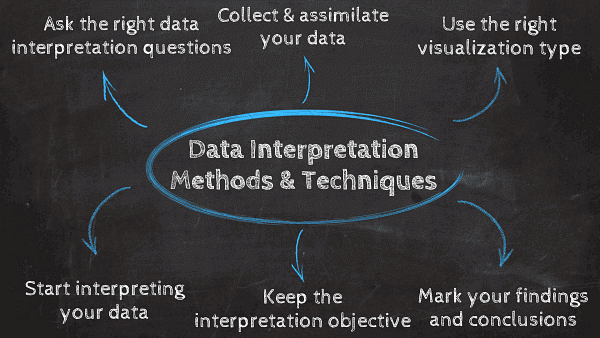Notes: Basics of Data Interpretation | Data Interpretation for UGC NET PDF Download
| Table of contents |

|
| Data Interpretation |

|
| Qualitative Data Interpretation |

|
| Quantitative Data Interpretation |

|
| Importance of Data Interpretation |

|
| Key Pitfalls in Data Analysis |

|
Data Interpretation
The interpretation of data assigns a meaning to the information analyzed and determines its significance and implications.
It refers to the implementation of processes through which data is reviewed for the purpose of arriving at an informed conclusion.

- Keeping in view its importance, data mapping should be done properly. Data is obtained from multiple sources, so it needs to enter the analysis process with haphazard ordering.
- Data analysis is usually subjective and thus, the goals of interpretation may vary from one business to another.
- There are two main types of analysis: quantitative and qualitative.
Types of Scales of Measurement
- Nominal scale: It consists of non-numeric categories that cannot be ranked or compared quantitatively. Variables are exclusive and exhaustive.
- Ordinal scale: It includes categories that are exclusive and exhaustive but with a logical order. Examples include quality ratings and agreement ratings.
- Interval: This scale groups data into categories with orderly and equal distances between them. It always has an arbitrary zero point.
- Ratio: This scale combines features of all three types.
Interpreting Data
- When interpreting data, an analyst must differentiate between correlation, causation, and coincidences, among other factors.
- Two main methods of interpreting data are qualitative and quantitative analysis.
Qualitative Data Interpretation
Narrative data is primarily collected through various person-to-person techniques and is described as 'categorical'.
- The description is conveyed not through numerical values or patterns but through descriptive context or text.
Techniques for Data Collection
- Observations: This involves analyzing behavior patterns, such as the amount of time spent on an activity and the communication used.
- Documents: Different types of documentation resources can be classified and organized based on the material they contain.
- Interviews: Considered the most effective method for collecting narrative data, interviews allow grouping of responses by themes, topics, or categories. This approach facilitates focused data segmentation.
Data Collection Principles
- Notice things: Pay attention to details and patterns during data collection.
- Collect things: Gather relevant data systematically and comprehensively.
- Think about things: Engage in critical thinking to analyze and interpret collected data effectively.
Qualitative data, being open to interpretation, needs to be 'coded' to enable grouping and labeling into identifiable themes.
[Intext Question]
Quantitative Data Interpretation
It is a set of processes by which numerical data is analysed.
Quantitative data focuses on numerical analysis, involving statistical modeling techniques like standard deviation, mean, and median.
Common Statistical Terms
- Mean: Represents the numerical average for a set of responses.
- Standard deviation: Indicates the distribution of responses around the mean, the consistency within the responses, and insights into data sets.
- Frequency distribution: Measures the rate of response appearance within a data set, crucial for determining the consensus among data points.
Signature Interpretation Processes of Quantitative Data
- Regression analysis
- Cohort analysis
- Predictive and prescriptive analysis

 |
Download the notes
Notes: Basics of Data Interpretation
|
Download as PDF |
Importance of Data Interpretation
The purpose of collecting and interpreting data is to acquire useful information for making informed decisions.
Data interpretation involves:
- Data identification and explanation
- Comparing and contrasting data
- Identification of data outliers
- Future predictions
Common Issues with Data Interpretation
- Informed decision-making: Data analysis should involve identification, thesis development, data collection, and data communication.
Data Insights and Business Advantages
- Anticipating needs with trends identification: Data insights provide knowledge, and knowledge is power.
- Cost efficiency: Proper implementation of data analysis processes can provide businesses with profound cost advantages within their industries.
- Clear foresight: Companies that collect and analyse their data gain better knowledge about themselves, their processes, and performance.
Common Data Misinterpretation Risks
In addition to the benefits, there are challenges associated with data interpretation:
- Big Data Challenges: The adage 'big data equals big trouble' points to potential pitfalls that can occur during data analysis, particularly when done swiftly.
- Data Quality Issues: Inaccurate or incomplete data can lead to faulty conclusions. For instance, if a retail company analyses sales data without accounting for returns, the insights could be misleading.
- Confirmation Bias: This occurs when analysts favor information that confirms their preconceptions. For example, a marketing team reviewing campaign data might focus only on positive metrics while ignoring negative feedback, resulting in a skewed interpretation.
- Overfitting: This happens when a model is overly complex and fits the training data too closely, leading to poor generalization on new data. An example could be a machine learning algorithm that memorizes a small dataset instead of learning the underlying patterns.
[Intext Questions]
Key Pitfalls in Data Analysis
Correlation mistaken for causation
One common mistake in data analysis is confusing correlation with causation. This error happens when two events coincide, leading to the assumption that one event causes the other. It is crucial to understand that just because two variables are correlated, it does not necessarily mean that one causes the other.
Confirmation bias
Confirmation bias is a cognitive error where individuals tend to favor information that confirms their preconceptions or hypotheses while disregarding contradictory evidence. This bias can lead to flawed conclusions and erroneous data analysis.
Irrelevant data
Another pitfall in data analysis is the tendency to focus on irrelevant data points instead of the information that is pertinent to the problem at hand. With the vast amount of data available today, analysts may get distracted by irrelevant details, leading to misguided conclusions.
Factors to Consider for Data Analysis
- Collecting and Cleaning Data: Ensure that the data you gather is well-organized and free from errors or inconsistencies. This step is crucial as the quality of your analysis heavily relies on the cleanliness of the data.
- Choosing the Type of Analysis: Before diving into the analysis, it's important to determine whether a qualitative or quantitative approach is more suitable for the given data. Tailor your methods accordingly for each type of analysis.
- Considering Various Perspectives: Step back and contemplate the data from different angles. Think about how it impacts different stakeholders or participants involved in the project. This broader perspective can reveal deeper insights.
- Reflecting on Thinking Processes: It's crucial to introspect on your own thoughts and reasoning throughout the analysis process. Be wary of factors like correlation versus causation, subjective biases, false information, or inaccuracies in the data. These reflections help ensure the integrity of your conclusions.
|
17 videos|20 docs|16 tests
|
FAQs on Notes: Basics of Data Interpretation - Data Interpretation for UGC NET
| 1. What is the difference between qualitative and quantitative data interpretation? |  |
| 2. Why is data interpretation important? |  |
| 3. What are some key pitfalls in data analysis? |  |
| 4. How can one improve their data interpretation skills? |  |
| 5. How can data interpretation skills be helpful in cracking exams like UGC NET? |  |

























